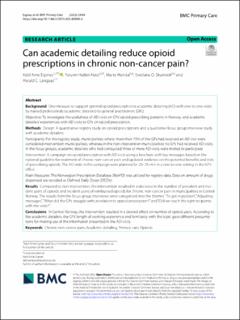| dc.contributor.author | Espnes, Ketil Arne | |
| dc.contributor.author | Nøst, Torunn Hatlen | |
| dc.contributor.author | Handal, Marte | |
| dc.contributor.author | Skurtveit, Svetlana Ondrasova | |
| dc.contributor.author | Langaas, Harald C. | |
| dc.date.accessioned | 2023-05-15T08:08:38Z | |
| dc.date.available | 2023-05-15T08:08:38Z | |
| dc.date.created | 2023-03-28T09:41:38Z | |
| dc.date.issued | 2023 | |
| dc.identifier.issn | 2731-4553 | |
| dc.identifier.uri | https://hdl.handle.net/11250/3067891 | |
| dc.description.abstract | Background
One measure to support optimal opioid prescription is academic detailing (AD) with one-to-one visits by trained professionals (academic detailers) to general practitioners (GPs).
Objective: To investigate the usefulness of AD visits on GPs’ opioid prescribing patterns in Norway, and academic detailers’ experiences with AD visits to GPs on opioid prescription.
Methods
Design: A quantitative registry study on opioid prescriptions and a qualitative focus group interview study with academic detailers.
Participants: For the registry study, municipalities where more than 75% of the GPs had received an AD visit were considered intervention municipalities, whereas in the non-intervention municipalities no GPs had received AD-visits. In the focus groups, academic detailers who had conducted three or more AD-visits were invited to participate.
Intervention: A campaign on opioid prescription with AD visits using a brochure with key messages based on the national guideline for treatment of chronic non-cancer pain and updated evidence on the potential benefits and risks of prescribing opioids. The AD visits in the campaign were planned for 20–25 min in a one-to-one setting in the GP’s office.
Main Measures: The Norwegian Prescription Database (NorPD) was utilized for registry data. Data on amount of drugs dispensed are recoded as Defined Daily Doses (DDDs).
Results
Compared to non-intervention, the intervention resulted in a decrease in the number of prevalent and incident users of opioids and incident users of reimbursed opioids for chronic non-cancer pain in municipalities in Central Norway. The results from the focus group interviews were categorized into the themes: “To get in position”, “Adjusting messages”, “What did the GPs struggle with, in relation to opioid prescription?” and “Did we reach the right recipients with the visits?”.
Conclusions
In Central Norway, the intervention resulted in a desired effect on number of opioid users. According to the academic detailers, the GPs’ length of working experience and familiarity with the topic gave different presumptions for making use of the information presented in the AD-visits. | en_US |
| dc.language.iso | eng | en_US |
| dc.publisher | BMC | en_US |
| dc.relation.uri | https://bmcprimcare.biomedcentral.com/articles/10.1186/s12875-023-02040-6 | |
| dc.rights | Navngivelse 4.0 Internasjonal | * |
| dc.rights.uri | http://creativecommons.org/licenses/by/4.0/deed.no | * |
| dc.title | Can academic detailing reduce opioid prescriptions in chronic non‑cancer pain? | en_US |
| dc.title.alternative | Can academic detailing reduce opioid prescriptions in chronic non‑cancer pain? | en_US |
| dc.type | Peer reviewed | en_US |
| dc.type | Journal article | en_US |
| dc.description.version | publishedVersion | en_US |
| dc.source.volume | 24 | en_US |
| dc.source.journal | BMC Primary Care | en_US |
| dc.identifier.doi | 10.1186/s12875-023-02040-6 | |
| dc.identifier.cristin | 2137453 | |
| dc.relation.project | Norges forskningsråd: 320360 | en_US |
| cristin.ispublished | true | |
| cristin.fulltext | original | |
| cristin.qualitycode | 1 | |

